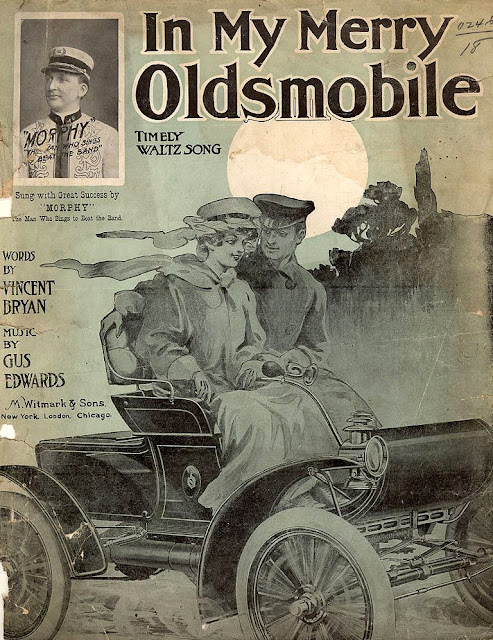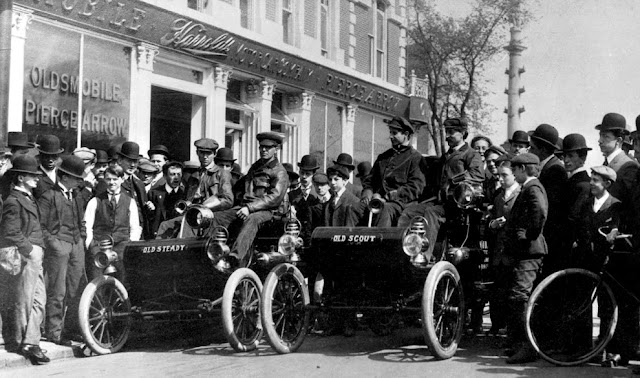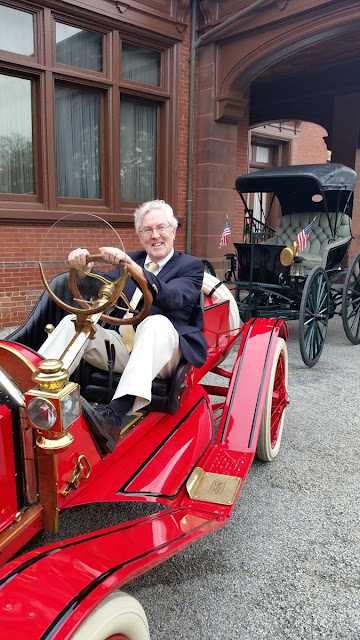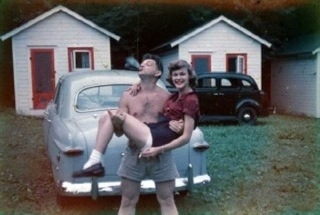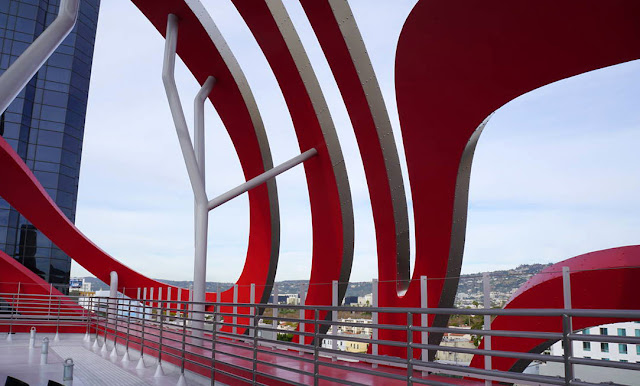Showing all posts tagged "Raymond Arsenault On Life And Business"
110 years ago, this was the number 1 song. So popular, that 40 years ago, I learned it as a kid
via Raymond Arsenault on Life and Business http://raymondarsenault.blogspot.com/2015/12/110-years-ago-this-was-number-1-song-so.html
Posted on December 6th, 2015
Car Crazy, by G Wayne Miller... book review
This isn't a book with photos... there might be 8 in the whole book, but it doesn't need them, it's a history, a documentary almost, and does the best job of teaching you everything about the 1st decade of American car making (1900-1910) that I think we are ever likely to get.
If you were to want to learn how the Ford, Olds, Reo, Chevrolet, Buick, and GM got started, this book is indispensable. It's really that good.
How these prominent car companies were started, what they had to overcome to succeed, how they had to fight the Selden patent, and why they went bankrupt, or were bought and merged.
But more than that, it's an eye opener on how the roads weren't ready for cars, or driving enthusiasts, now were the only things on the primitive two rut dirt roads of that time, horses! Ever think how the horse drawn wagons handled suddenly sharing the road with fast, noisy, and smelly early cars?
Also, how cross country endurance racing was started, and this very closely goes through the race between the curved dash Olds - Old Steady, and Old Scout... plus a bit about the Reo Mountaineer that soon followed.
Then it also looks at the Glidden tours, the Vanderbilt Cup, and some other races, and the men that became famous int he early racing madness, Barney Oldfield, Cooper, Keeler, and Huss.
I've covered a lot about these things in the last year or two, and have barely touched the amount of information that the Author of Car Crazy covered. It's stunning how much research he did, and how much he has to teach people like me, that figure we have a good handle on the basics.
By the numbers, (as John coined the phrase):
11 chapters that take 290 pages,
one epilogue of 8 pages,
and acknowlegements 4 pages
then notes 26 pages,
then bibliography and index
Chapter one excerpt is available to read http://www.gwaynemiller.com/carexcerpt.htm
But having told you how damn good I think this book is, I'll now jump into some of the cool things I learned in it that I want to share with you:
The test driver for Olds, on the 1901 curved dash Olds was Roy Chapin, later in life would be the founder of the very successful Hudson Car Co, and then the US Secretary of Commerce
in 1904 when R E Olds was losing the fight to control Oldsmobile, Billy Durant, future founder of GM was still making horse carriages, and didn't care to attend the New York Auto Show, now as formidable as the Paris Auto Show
Henry Ford actually was a speed demon until the company need for his leadership was made very clear to him, after several other drivers died in racing, but when he was young and foolish, he set the land speed record of 100mph on frozen Lake St Clair in order to get publicity for the soon to occur Madison Square Garden New York Auto Show, Jan 1904. He had the famous 999, and another twin car, the Arrow. I've never heard of the Arrow before. But the New York Times was firmly against cars at the time, especially racing cars (another thing I learned) and routinely ran opinions in the editorial, and had this to say about "young speed maniac" Ford trying to break the speed record: the true harm of record setting runs "is that it will lead a number of idiots to try similar exploits on public roads"
The Times was so adamantly opposed, at this time, that it asserted the owners of cars should be prosecuted, and the possession of cars should be illegal. Yeah, most cars in 1903-04 were in New York City, and were killing pedestrians. It contended that cars were so deadly due to their speed, that if the owner could show restraint, surely a servant would take the car and go dashing madly on streets, "curiously, those want to go fastest whose time is worth least"
New York City was ground zero for car need... the horses polluted, they took up space, and feed, and they were twice the length of a car when harnessed to a carriage or wagon.... all negative when compared to the car, which could carry twice the load, at twice the speed, in half the length, with 5 times better braking. Loud whips and horse clopping shoes were also strong arguments to remove horses from NYC, and replace them with rubber tires. Quiet, odorless, and not creating piles of horse manure, and puddles of piss. NYC had 130,000 horses, Chicago had 74,000, and Philly 51,000. Summer heat and the stench alone was aggravating city people, and often, the street cleaners couldn't keep up, and when horses died, the owners frequently left them on the roads bloating and rotting. The flies the excrement created.. must have been abominable in that era before modern sanitation and medical knowledge of disease carried by flies. Horses were viewed as a public health hazard.
Barney Oldfield challenged Henry Ford to a race at Ormand, for $5,000. Oldfield knew he cold win a speed contest and thought he'd break Henry's 100mph, by at least 30mph. Ford didn't want to lose the good publicity he'd gained with the 100mph record, safely gained, in a risk that the worst could happen.
The French auto industries attitude rubbed early American car owners wrong, and they wanted to get rid of French vehicular words like Automobile, Chauffeur, and Garage
The first drivers had a lot of problems with farmers, and their dogs. The ammonia squirt gun was effective, and in previous use with postal delivery, but the best tool was found to be a sling shot to deter dogs from harassing drivers and cars.
the 1st cross country drive was in a Winton (San Fran to NY, 63 days, 1903), http://justacarguy.blogspot.com/2015/07/the-first-automobile-to-successfully.html
the second in a Packard (same run, starting 6 weeks later, 62 day),
and then the idea got around to Olds when a 1904 did the same in 71 days, 6 weeks after the Packard), but not before a Franklin left San Fran 5 weeks later (32 days), and then Oldsmobile went all out with the race between Old Steady and Old Scout
20 miles east of Manhattan was a place primarily Quaker farming, until the car drivers discovered it was great for racing, instead of polo and fox hunting.. and the Vanderbilts, Whitneys and Goulds were now suddenly in love with racing their cars tot he country clubs instead of horse carriage rides
the 1st survey of American roads was in 1904, about 2 million miles of roads existed, but only 154k were upgraded to stone, gravel, or other improvements for smoothness. Old Indian trails were still being used.
President Jefferson had signed a bill in 1806 to get the "National" road built, from the Potomac, to Virginia. In 1820, it was added to, and authorization was given to pay for the road to stretch to St Louis, by 1838, it still wasn't completed. Nothing was on the roads but horse drawn carriages and wagons, and no one thought it was important enough to complete. Bicycles came along in the late 1870s
In the 1880s, roads for bikes were getting important, and in 1891 and 92 there was becoming a lot of concerned people who wanted the roads improved for everyone, not just bikers, but farmers too. Smooth roads cause less trouble for horses legs, riders butts, and wagon drivers jangled teeth.
In 1892, Isaac Potter, Civil War vet and civil engineer, writing for the League of American Wheelmen, stated the obvious, the conditions of roads were the character of the nation. "The road is that physical sign or symbol by which you will best understand any age or people If they have no roads they are savages for the road is the creation of man and the type of civilized society " Road Contruction and Maintenance: Prize Essays
The first vocal advocates of good roads inspired a great experiment, the demonstration paved road. Pave a piece of road, and then people will obviously fall in love with it, and demand more from the govt, the 1st one was started at the entrance to an agricultural school in New Brunswick New Jersey, and cost the govt $321.
The trains connecting the country from East to West took advantage of the discoveries of coal in Wyoming by trappers, and Congress GAVE the mineral rights to the train companies along with land grants. If not for coal, Wyoming would not have been settled at all, it wasn't good farming country.
During the cross country race with the curved dash olds, "sand tires" were brought along, and were 10 inches wide, instead of the normal 2, constructed of boards, buckles, canvas, hair, and straps. http://justacarguy.blogspot.com/2014/12/old-scout-and-old-steady-endurance-race.html
Deaths in 1905 races of celebrity drivers, turned public opinion against racing, and in an attempt to divert the bad publicity from affecting ordinary cars, and sales, when they were just starting to gain ground with quality, production numbers, and it was staring to look like cars might gain wide public appeal, the Buffalo New York State Automobile Association president, Bill Hotchkiss, tried to get a state supreme court injunction to stop track races from occurring. If racing killed drivers, public prejudice would grow, and more restrictive laws hobbling the automobile manufacturers would get passed. A 1/3rd of newspaper space was just about car accidents and other bad press for cars, in Nov 1905.
The two most vocal papers in 1905 were on opposite sides of the car issue... the Automobile, and the New York Times. Yup... right until the owner of the times bought a car. Then, complete turnabout on all editorial content. Of course, the vehicle was chauffeur driven, and immediately was busted for speeding, contrary to all previous NYT blathering about how bad motorists were, how terrible their speeding about, and suddenly with the purchase of a car, hypocrisy was smacking the NYT across the face. The Automobile used this against the times, and a war between the two ensued
R E Olds was ousted by some schmuck named Smith, who killed all forward progress in the Oldsmobile company, stubbornly driven to make very expensive cars, completely 180 from the proven profitable business model of all auto companies in history... inexpensive cars keep companies very profitable, and the curved dash Olds was at the time, the best selling car, and strongest company. Smith tried something called the Palace Touring and Gentlemans Roadster. They were 4 times the cost of the runabout curved dash.
Ford knew the wisdom of selling cheap cars, small, light, and easy to repair cars... tires of 1905 weren't very developed. They were barely a step up from rock hard vulcanized tar. They didn't last long, and they were even faster to get damaged by heavy vehicles, than light ones. If you wanted to make your tires last, you got a light small car. Plus Ford argued logically, that few people could afford a mechanic to ride along, or a chauffeur, so why spend 3 or 4 times what a simple car cost, when nothing got you where you were going any better, no matter what the cost. Keep in mind, most vehicles didn't have tops, side windows, heaters, fans, etc etc. You were going to get wet, hot, or freeze no matter what you were driving, so why waste money? And the more expensive the car, the more expensive the repairs, that is still a fact.
Car insurance... started out from a marine insurance company, Boston Ins Co, founded 1873. They charged 3% of the value of the car to insure it, annually. I wonder, how much more, or less, do we pay now for the same insured risks? Fire, theft, pilferage, lightning.
Olds engineer Ernest Keeling was the driver during the 1905 car show demonstration tests, and one of these was the vibration test... a pail of water was carried in the car for 200 yards at speed, from a standing start.
Mark Twain seems to have invented the idea of license plates, he advised after a family member ws near killed by a speeding motorist, that numbers be required on the back of cars 2, 3, and 4 feet high to disgrace the offending drivers
The Selden Patent people (ALAM) created fake court cases, and had actors be defendants, to win court cases, and set legal precedent, by having the planted stooges admit to having wrongfully sued Selden Patent reps, and them admit to wrongdoing. So, this ongoing fraud made a bunch of successful court wins for the ALAM and they then tried to use these legal cases to sway judges in harder, real, court battles.
The first Vanderbilt Cup race is incredibly transcribed starting on page 259... it's simply a joy to read as if you were there in every car, and learn what happened to each. They weren't ready to race, I can tell you. I covered this a bit http://justacarguy.blogspot.com/2013/12/1906-vandebilt-cup-competitor.html
Billy Durant, once the savior of Buick, and millionaire by the age of 42 because of horsecart company ownership and expert salesmanship, had once had Louis Chevrolet race his Buicks, went to co-found the Chevrolet company. Then lost control, then bought up enough shares in GM to control it again, then lost his entire fortune in the stock market crash in 1929, and 11 years later was the manager of a bowling alley at age 78
Barney Oldfield lost all his money int he 1929 crash, and became the Plymouth highway safety advisor. He wanted to try for the 300mph speed record, but wasn't near able to get the funding and sponsorship after the stock market crash, in the midst of the great depression, and in 1935 Campbell nailed 301 in the Bluebird on Bonneville
110 years after the 1905 Olds, Chevrolet sells a motor 100 times as powerful. The Z06 is a 650 hp engine
Henry Ford left several car companies behind, with his name on them. The Henry Ford Company, which later became Cadillac, Ford and Malcomson, and Ford Manufacturing Company. The current company is the Ford Motor Company
http://www.gwaynemiller.com/
http://gwaynemiller.blogspot.com/
https://www.instagram.com/g.waynemiller/
via Raymond Arsenault on Life and Business http://raymondarsenault.blogspot.com/2015/12/car-crazy-by-g-wayne-miller-book-review.html
Posted on December 6th, 2015
Tony added more stickers to his Ebay store, here are the ones I like the most
head to http://www.ebay.com/sch/m.html?item=381484205522&ssPageName=STRK%3AMESELX%3AIT&_ssn=tchop77&_sop=1&rt=nc
for the whole selection
via Raymond Arsenault on Life and Business http://raymondarsenault.blogspot.com/2015/12/tony-added-more-stickers-to-his-ebay.html
Posted on December 6th, 2015
men and women see things differently
A wife was curious when she found an old negative in a drawer and had it made into a print.
She was pleasantly surprised to see that they were of her at a much younger, slimmer time, taken many years ago on one of her first dates with her husband.
When she showed him the photo, his face lit up.
He said with appreciation, "Wow, look at that, it's my old Ford!"
via Raymond Arsenault on Life and Business http://raymondarsenault.blogspot.com/2015/12/men-and-women-see-things-differently.html
Posted on December 6th, 2015
Pawtucket's Modern Diner Custard French Toast is best in America according to Food Network show
The birthplace of the diner, Modern Diner is operated inside of an old rail car just like the first diners were. Nick Demou and his father opened the place 28 years ago. In 1978, the Modern became the first diner ever entered on the National Register of Historic Places
Since then the restaurant’s top dish has become the Custard French Toast, born out of an accident. Fifteen years ago Nick had made too much vanilla pudding, so he thinned it down and served it as a custard on French toast made from thick-cut Texas toast. It also includes a topping of fresh strawberries, blueberries, sliced kiwi, house-candied pecans and raspberry syrup.
Also on the list: No. 2 Chicken Pot Pie at the Agawam Diner in Rowley, Massachusetts;
No. 3 the Nebulous Potato Thing at St. Francis Fountain in San Francisco’s Mission district;
No. 4 The BW Benny at Harry’s Coffee Shop in La Jolla, California; and
No. 5 Meatloaf at 24 Diner in Austin, Texas.
http://www.providencejournal.com/article/20151201/ENTERTAINMENTLIFE/151209914/SHARED/st_refDomain=t.co&st_refQuery=/3avAfHdBxN
via Raymond Arsenault on Life and Business http://raymondarsenault.blogspot.com/2015/12/pawtuckets-modern-diner-custard-french.html
Posted on December 5th, 2015
Look at the turn signal on this Packard bus (in the AACA museum)
Cool, I've never seen that before
Found on http://www.amerisud.fr/forum/viewtopic.php?f=11&t=1870&p=22549
via Raymond Arsenault on Life and Business http://raymondarsenault.blogspot.com/2015/12/look-at-turn-signal-on-this-packard-bus.html
Posted on December 5th, 2015
Key Tweets from @MarkGraban – Week of November 30, 2015: Deming, Kata, Lean, Safety…

Here’s the latest installment of “Key Tweets,” a weekly post that summarizes some of my tweets (or retweets) from the week, including pictures and other fun stuff. Follow me @MarkGraban and join the fun and the conversation. See the previous installments of Key Tweets here.
If you’re reading this via email or RSS, you might get a better experience by clicking through to view the post on the web because it will display article link previews, embedded photos, etc., providing a better reader experience for you.
A friend says a @TSA agent told him "Unfortunately many of our policies are open to interpretation so it really depends on the agent."
— Mark Graban (@MarkGraban) November 30, 2015
Episode #5 of the Toyota #Kata Podcast has been released https://t.co/sZVLQ9Qhtr Subscribe here: https://t.co/8fOVFORWgc
— Mark Graban (@MarkGraban) November 30, 2015
British nursing publication editorial – “once again finance is being put before the safety of patients.” https://t.co/XrkYoExhNG
— Mark Graban (@MarkGraban) November 30, 2015
“Systems where employees are stack-ranked… reducing total motivation and thus performance.” https://t.co/XCtMz36J98 #Deming
— Mark Graban (@MarkGraban) November 30, 2015
This is a great intro to Lean book… Pascal is one of the best to be learning from… #Lean https://t.co/aTzOAtRdgD
— Mark Graban (@MarkGraban) November 30, 2015
Check out John Toussaint's new videos on #Lean healthcare https://t.co/TDjSSB5LQ9
— Mark Graban (@MarkGraban) November 30, 2015
Healthcare System Transformation Videos by John Toussaint, MD https://t.co/hDBsyotUx5 via @YouTube
— Steve Bollinger (@stevenbookman) November 30, 2015
Five Key Words of the Toyota Way – #Lean https://t.co/bvbMD98KcN pic.twitter.com/6nbCX4hTWV
— Mark Graban (@MarkGraban) December 1, 2015
Speaking tips — "When really charismatic leaders use hand gestures, the brain is super happy," https://t.co/xdXvrTVlEX
— Mark Graban (@MarkGraban) December 1, 2015
#Lean + layoffs will not be a recipe for Lean success in Saskatchewan cc @MMandryk https://t.co/dfWIAzcPxp
— Mark Graban (@MarkGraban) December 1, 2015
Article quoting @epatientdave on being an engaged patient https://t.co/rAGt199FbQ
— Mark Graban (@MarkGraban) December 1, 2015
Toyota safety & employee health data shared on website: https://t.co/bvbMD98KcN #Lean pic.twitter.com/scuNyz346I
— Mark Graban (@MarkGraban) December 1, 2015
“Toyota used a "PDCA for Improving Health" worksheet at each workplace,” https://t.co/bvbMD9ql4l #LEan
— Mark Graban (@MarkGraban) December 1, 2015
Mike Rother: "Improvement #Kata is not a problem solving methodology, it's a process of skill development." https://t.co/GC6gTkeJyo #Lean
— Mark Graban (@MarkGraban) December 1, 2015
Paul O'Neill speaking at @LeapfrogGroup annual gala on #patientsafety & leadership pic.twitter.com/z9HBnovWAI
— Mark Graban (@MarkGraban) December 2, 2015
It's always inspiring to hear Paul O'Neill speak – here are my notes from a 2013 talk he gave: https://t.co/sKYU12AN62 #lean #patientsafety
— Mark Graban (@MarkGraban) December 2, 2015
Heard him speak again tonight at @leapfroggroup – My 2011 podcast with him – Paul O’Neill on #PatientSafety https://t.co/g86lnwljNY
— Mark Graban (@MarkGraban) December 2, 2015
For most operations is about lowering costs.But when used right operations is also about dignity, good jobs. We need to emphasize that more
— Zeynep Ton (@zeynepton) December 2, 2015
New study on MD #burnout very troublng; now >50%, up 9% since 2011 https://t.co/Xky9fILwyz Gotta fix this @AmerMedicalAssn @ChristineSinsky
— Bob Wachter (@Bob_Wachter) December 2, 2015
I share Paul O'Neill's frustration, stated last night, that the huge successes in healthcare aren't being duplicated & spread more widely
— Mark Graban (@MarkGraban) December 2, 2015
Many organizations struggle with #Lean because they view it as "tools in the toolbox" or they layer tools on top of the wrong philosophy
— Mark Graban (@MarkGraban) December 2, 2015
"It can be better, and it needed to be better – for their patients." The power of #Lean healthcare @MarkGraban pic.twitter.com/shcksgUXeD
— The Leapfrog Group (@LeapfrogGroup) December 2, 2015
@MarkGraban: other industries don't put quality control on their customers #AskMeIfIWashedMyHands @LeapfrogGroup pic.twitter.com/d5SWEn9ZcJ
— MBGH (@MemphisBGH) December 2, 2015
@MarkGraban: humility is a main ingredient in successfully implementing lean #livingthevision @LeapfrogGroup pic.twitter.com/FbqILRbvbj
— MBGH (@MemphisBGH) December 2, 2015
When it's easier to fudge the numbers instead of actually improving the system… https://t.co/JqjrmulYJ8
— Mark Graban (@MarkGraban) December 2, 2015
How many hospitals have missed the point of #Lean, somehow thinking that it's all about speed, efficiency, cost, not #safety & #quality?
— Mark Graban (@MarkGraban) December 3, 2015
Read & commented: Rethinking the Shadow Board https://t.co/EIvZDoDHFx By @danmarkovitz #Lean
— Mark Graban (@MarkGraban) December 3, 2015
YouTube: LeanBlog Podcast #235 – @LeanLeaderWay Interviewed by Mark Graban on #Lean Leadership https://t.co/NlsO41nms4
— Mark Graban (@MarkGraban) December 4, 2015
9 Gift Ideas for Your #Lean Loving Friends https://t.co/Q6ueQPO7GH
— Mark Graban (@MarkGraban) December 4, 2015
We need to address this in healthcare. Don't set people up to struggle or fail https://t.co/3k7Twc8iwL
— Mark Graban (@MarkGraban) December 5, 2015
Thanks for reading! I’d love to hear your thoughts. Please scroll down to post a comment (or click through to the blog if you’re reading via email or RSS).
Original article: Key Tweets from @MarkGraban – Week of November 30, 2015: Deming, Kata, Lean, Safety….
(c) Mark Graban and Constancy, Inc. 2005-2015
via Raymond Arsenault on Life and Business http://raymondarsenault.blogspot.com/2015/12/key-tweets-from-markgraban-week-of.html
Posted on December 5th, 2015
Hemmings Find of the Day – 1989 Mercedes-Benz AMG W124 Hammer
When BMW debuted the M1-powered M5 sedan as a concept in 1984, Mercedes-Benz tuner AMG countered the threat by building a hot-rodded version of the E-Class, infused with a tuned V-8 borrowed from the 560 SEC and rated at 355 horsepower. Dubbed “The Hammer,” AMG’s super sedan could also be ordered with an engine bored to 6.0-liters and blueprinted, an option that added nearly $40,000 to the Hammer’s $56,000 base price tag. Few were built, and among Mercedes-Benz performance enthusiasts, the cars remain a coveted piece of AMG history. This 1989 Mercedes-Benz AMG W124 Hammer, for sale on Hemmings.com, comes with the 6.0-liter V-8, rated at 385 horsepower and good for a claimed top speed of 190 MPH. The interior is said to be original and in excellent condition, and mechanically the car is described as in great condition and well-maintained. From the seller’s description:
This 1989 AMG Hammer currently shows only 48000 miles on the odometer, this a genuine 6.0L version of AMG’s legendary four door supercar. The W124 was arguably a peak for Benz, both in terms of build quality and style, at least for those of us who love blocky, minimal Eighties German design. look is a huge win. Though subtle by today’s standards, the bespoke body kit worn by Hammers was actually pretty extreme for the time. Overall it’s aged superbly and makes us pine for the days when engineering and not marketing dictated the shape of MB’s cars. .
Inside its 100% original with signature Recaro interior , and wurl wood trim.. The interior is in excellent condition. Black leather in a black car is a classy look, and apart from a 320 KMH speedometer, the only way you’d know you were in something a bit more special than a 300E is the sleek AMG body kit and original black 3 piece AMG wheels
Standard displacement for these later Hammers was 5.6 liters, though this one runs the optional overbore 6.0 motor. M117 based, AMG motor with DOHC good for 385HP in these ultimate six liter versions. This one should be good for 190 MPH (or more, depending on which report you believe) all-out. It looks quite clean under the hood, though totally unassuming with a standard MB air cleaner housing. The car is in great mechanical condition, and as we expect it’s been well-maintained–these were not inexpensive machines after all, originally sticker price was $160.000 when new nearly three decades ago.
Come 1990 the less-expensive, more widely available Porsche-built 500E would steal much of the Hammer’s impact, but as great as that car was it doesn’t come close to the AMG in terms of exclusivity or street cred.
Find more Mercedes-Benz for sale on Hemmings.com.
via Raymond Arsenault on Life and Business http://raymondarsenault.blogspot.com/2015/12/hemmings-find-of-day-1989-mercedes-benz.html
Posted on December 5th, 2015
Four-Links – hydrostatic chopper, Unsafe, Dave MacIntosh, Pickwick
What you see above may not be immediately recognizable as any form of transportation, but as Engine Swap Depot pointed out this week, it’s something that would make Ray Russell proud: Sam Turner’s twin-turbocharged diesel two-wheel-drive hydrostatic-drive chopper. The ingenuity throughout this thing is impressive.
* This past week marked the 50th anniversary of the publication of Ralph Nader’s “Unsafe At Any Speed,” a book that, as The Detroit Bureau estimated, saved as many as 3.5 million lives in the decades since.
* Dave McIntosh’s designs from his 40-year career with General Motors were the topic of a recent Dean’s Garage retrospective.
* In addition to the ungainly looking road leviathans most auto historians associate with the name, Pickwick also put into service a small fleet of Dwight E. Austin-designed Columbia Coach Works-built Nite Coaches that The Old Motor recently profiled.
* Finally, Motor Mavens put together a brief but intriguing look at the Japanese bosozoku bike-gang subculture, specifically the underage girls that participate in it.
via Raymond Arsenault on Life and Business http://raymondarsenault.blogspot.com/2015/12/four-links-hydrostatic-chopper-unsafe.html
Posted on December 5th, 2015
The Pete has re-opened, after refurbing the exterior... Autoweek did a great job taking photos of the cars inside, and you can save yourself the trip, but it looks like the exhibits finally got a long over do cleanout. Nothing looks like it did, it look s
A total of 100 automobiles, 23 motorcycles, four scooters, one bobsled and one full-sized Lightning McQueen are on the grid as the museum throws open its doors again on Sunday, Dec. 6 in a special $200 “Preview Day.” After that you can get in for a mere 15 bucks, a pittance compared to the $90 million spent on the renovation.
Autoweek says:
"The ribbons float around the building "evoking imagery of speed and the organic curves of a coach-built automobile,” the museum says. OMG. Love it or hate it (and the only people we've heard say they love it are on the board of the museum)
Among the new Petersen’s many opening exhibits. "Precious Metal" features 10 beautiful silver cars on silver stands in a silver room with a silver backdrop.
well done, great execution of the theme
and here is one example of the huge improvement in displays
and FINALLY we know where the Tomohawk is
http://autoweek.com/article/car-news/petersen-museums-100-million-makeover
via Raymond Arsenault on Life and Business http://raymondarsenault.blogspot.com/2015/12/the-pete-has-re-opened-after-refurbing.html
Posted on December 5th, 2015

